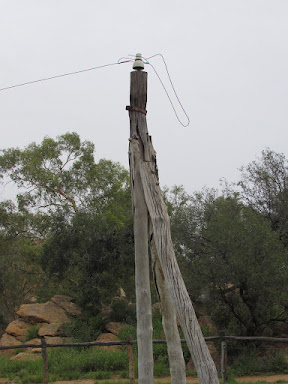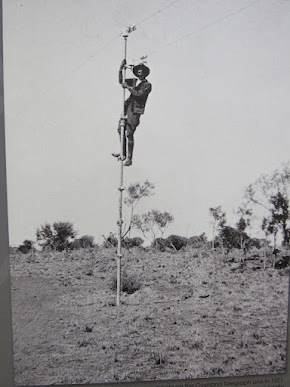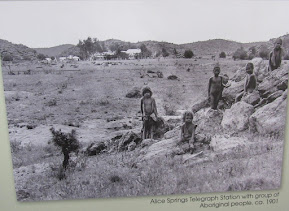A telegraph station on the itinerary? In the middle of nowhere? Are you kidding?
It turned out that we were visiting the station because it not only played a significant role in connecting Australia with the rest of the world, but it transformed the social and cultural lives of those who had lived here for thousands of years and those newcomers who wanted to mold the continent in their own image. Yes, this placeless place near a waterhole was essential to our understanding of Australia's history, present-day politics--and how extreme desires can lead to extreme efforts to achieve extreme ends. This is the story of the Overland Telegraph Line at Alice Springs.
 Samuel B. Morse conceived the idea of an electric telegraph in 1832 after hearing about the newly-discovered electromagnet. Electric messages had been sent short distances as early as 1774, however, Morse made his first working model by 1835. Through friends and colleagues he devised a telegraph that could send messages over 10 miles. In 1838, Morse and Alfred Vail developed a system of dots and dashes, which later became known as Morse Code. After several tries, he finally obtained financial support from Congress in 1843 for America's first telegraph line from Baltimore to Washington. The line was
completed in 1844, and on May 24 he sent the first message, “What hath God
wrought.”
Samuel B. Morse conceived the idea of an electric telegraph in 1832 after hearing about the newly-discovered electromagnet. Electric messages had been sent short distances as early as 1774, however, Morse made his first working model by 1835. Through friends and colleagues he devised a telegraph that could send messages over 10 miles. In 1838, Morse and Alfred Vail developed a system of dots and dashes, which later became known as Morse Code. After several tries, he finally obtained financial support from Congress in 1843 for America's first telegraph line from Baltimore to Washington. The line was
completed in 1844, and on May 24 he sent the first message, “What hath God
wrought.”

By
the mid-19th century, the world was connected via the telegraph with lines a common sight in England, Europe, and
America. Insulated cables laid on the sea floor enabled rapid
communication across the oceans. Australia, however, was left behind due to its geographical isolation. That meant that writing family or
friends in Europe would take 2 months by ship and another several months for a reply. With the
Overland Telegraph Line, two-way communications could take place within a few
hours.
Australia's first telegraph line was erected in 1854 between Melbourne and Port Melbourne, about 3 miles away. Within five years, lines were hooked up between most of the colonies and to Tasmania by undersea cable over 400 miles long. However, the biggest change that ended Australia's isolation from the rest of the world was the cable laid across the Indian Ocean to the north coast at Port Darwin.
 A single wire installed from Darwin through Australia's interior and linked to Adelaide in the south could become the path for a new frontier and open up the Outback to Europeans' colonial interests.
A single wire installed from Darwin through Australia's interior and linked to Adelaide in the south could become the path for a new frontier and open up the Outback to Europeans' colonial interests.
A Dream Conceived
Prior to the telegraph, news and letters from Europe took at least two months to reach the Australian colonies by ship. The inability to communicate directly with England hampered trade, business transactions, and personal communication.
In the 1850s a number of British businessmen floated proposals for linking Australia to the new global telegraph network.
Australia was not a unified country with a central government at the time, but rather six separate British colonies. The colonial governments were keen to see an undersea cable laid to the Australian coast but it took a while before they could agree on where and how the colonies would share the costs.
In 1858, the South Australia Governor, Sir Richard MacDonnell, proposed landing the cable on Australia's north coast in Darwin and building an overland telegraph line to Adelaide. MacDonnell was optimistic this would benefit South Australia. However, the South Australian Government faced fierce opposition from Queensland (northeast Australia) which wanted a line built across northern Australia to link with their existing telegraph network. The South Australians prevailed on April 29, 1870, when they offered to pay the full cost of building the line and to complete it by January 1, 1872.
European
explorers found the Central Australia a challenging and hostile
landscape. Crossing it proved to be a trial of human
endurance.
John McDouall Stuart had made several attempts to cross the continent before successfully reaching the northern coast from the south on July 24, 1862. Stuart's route, which followed sources of water that he found and mapped across the dry interior, became the basic path for the Overland Telegraph Line.
Living in the bush was difficult due to the unforgiving sun, limited provisions, and endless flies constantly buzzing around. Stuart was overwhelmed and he nearly died from malnutrition due to a lack of fruits and vegetables. However, he was the first man to cross the continent, which could be compared to being the first man on the moon. On the other hand, as harsh as the desert was, Stuart couldn't give it up; he was almost obsessive about it. He was an alcoholic and found that he could stay away from drink while in the bush. As a result, his motivation allowed him to do more than anyone else to open the continent and the Northern Territory. The Stuart Highway, named in his honor, runs through the Red Centre.
A Dream Realized
Construction of the Overland Telegraph (OT) Line from Port Darwin to Adelaide is recognized as one of the great engineering achievements of the 19th century. Charles Todd, South Australian Superintendent of Telegraphs, masterminded the work. He was a man of exceptional drive and an eternal optimist and gained international prestige for the colony and himself at the completion of the project.
Initially, he was unenthusiastic about MacDonnell's plan to build an overland telegraph line across the unexplored center of the continent. Three events changed his mind:
(1) John McDouall Stuart successfully crossed the continent in 1862.
(2) Undersea cable became much more expensive and made the overland telegraph line a more viable option.
(3) The South Australian Government succeeded in establishing a settlement at Port Darwin on the north coast in 1869, which would provide a landing place for the overseas cable and a base for constructing a line south.
The "singing wire" was strung across 1,865 miles of territory that was largely unexplored. There were no towns along the way and everything had to be transported overland.
The deadline imposed by the British Australian Telegraph (BAT) Company allowed only 18 months to construct the OT Line. Only after planning had begun in earnest did Todd come to terms with the task.
"And then, perhaps for the first time, I fully realised the vastness of the undertaking I had pledged myself to carry out."
The path of the OT Line was divided into three sections to be built simultaneously. Contractors would build the northern and southern sections and government parties would construct the central section.
Todd thought that the central section would be hardest to build but the line was erected with few problems. The work was divided between five government working parties, each comprised of about 25 men led by an experienced surveyor.
E.M. Bagot, the contractor for the southern section, and his team worked steadily north from the existing telegraph station at Port Augusta. Much of this area had already been explored and their only difficulty was finding suitable timber for the poles. This section was completed within the contracted time.
 The first pole in the northern section was erected on September 15, 1870, just one week after the contractors Darwent and Dalwood arrived at Port Darwin. Progress was good for two months but then the wet season arrived. The pace of work slowed in the rain-soaked boggy soil, but by Christmas they had installed poles to Pine Creek, 115 miles south of Port Darwin. However, the workers refused to go any further in the terrible conditions. Government supervisor William McMinn then rashly cancelled the contract and many of the men returned to Adelaide. Barely any work was undertaken in the next dry season.
The first pole in the northern section was erected on September 15, 1870, just one week after the contractors Darwent and Dalwood arrived at Port Darwin. Progress was good for two months but then the wet season arrived. The pace of work slowed in the rain-soaked boggy soil, but by Christmas they had installed poles to Pine Creek, 115 miles south of Port Darwin. However, the workers refused to go any further in the terrible conditions. Government supervisor William McMinn then rashly cancelled the contract and many of the men returned to Adelaide. Barely any work was undertaken in the next dry season.
Upon hearing the problem, Todd sent Robert Patterson north to sort out the mess. After more mishaps and little further progress, another wet season arrived. It was clear that the northern section would not be completed on time. Todd responded by taking control himself. He sailed north with new workers and fresh supplies.
The BAT Company succeeded in bringing the cable ashore before the due date. The 1,668-mile line was finished on August 22, 1872. This plaque celebrates its achievement.
 The
OT Line went
through the desolate heart of Australia and across the Indian Ocean by cable to the Northern Territory. Completed in 1872, the wire
stretched overland 1,865 miles and followed John McDouall Stuart's plan for
a significant part of the route. This
engineering marvel employed hundreds of people working in construction, operations, and maintenance.
The
OT Line went
through the desolate heart of Australia and across the Indian Ocean by cable to the Northern Territory. Completed in 1872, the wire
stretched overland 1,865 miles and followed John McDouall Stuart's plan for
a significant part of the route. This
engineering marvel employed hundreds of people working in construction, operations, and maintenance.
Establishing the Alice Springs Telegraph Station
The telegraph station was set up near what would become Alice Springs because of this water hole. William
Mills, telegraph line surveyor, assumed that it was part of an inland
river system. It was actually a depression in the river bed where water became trapped on top of a layer
of impervious granite. The water is close to the surface and
station staff subsequently used a whip to draw it up. The "Afghans" called this ancient
device a "shaduf". The first windmill was later erected in August
1914 to do the job.
Apart
from Antarctica, Australia is the driest place on Earth with 35% of the
land receiving so little rain it is considered a desert. In Central
Australia water was a vital resource for the Aboriginal people. They
camped around this waterhole they called Atherreyurre. According to their ancient lore, Arenge, an old hill-kangaroo spirit ancestor, dug the waterhole during the Dreamtime (Creation).
The electric telegraph was the Internet of the 1800s, and it changed the way governments and businesses were run. A single wire conveyed news and business. It was the "umbilical cord" that connected the remote colonies with the world.
The telegraph also opened central and northern
Australia to European expansion. Along the OT Line, as it became known,
the "maintenance track" became a path for travellers to venture out into new frontiers that encouraged further settlement of the region by
providing support and communication to remote areas. The track became a
line of wells and natural springs and waterholes for thirsty livestock.
 As the cattle and sheep industry grew, "the track" became part of a network of government stock routes and stations along the OT Line. The average size of these stations was 1,000 square miles or about the size of Wales. Contractors tapped the underground water supplies and "the track" became a line of wells and bores.
As the cattle and sheep industry grew, "the track" became part of a network of government stock routes and stations along the OT Line. The average size of these stations was 1,000 square miles or about the size of Wales. Contractors tapped the underground water supplies and "the track" became a line of wells and bores.
The telegraph station was the first European settlement in Central Australia. The building was originally a house. It became the Post and Telegraph Office where people posted letters or collected their mail from the late 1880s until 1932 when it re-located to Alice Springs. The building then became a hospital and clinic and Aboriginal children's home. This gum tree was here when the station was built.

For a long time, the OT Line was Australia's only
communication link with the rest of the world. Every word of world news
passed through it.
The Town of Alice Springs Is Founded
 During the mid-1800s southern Australia was in the grip of a depression, so people living on the sea coasts of the country traveled to the interior to seek their fortune or simply to scratch out a living. With the demands of this emerging population, the South Australian Government created small towns near the repeater stations that ran along the OT Line. This was how the town of
Stuart was established in November 1888, three miles south of the telegraph station. This growth also meant that the government instituted European-style administration, laws, and
customs.
During the mid-1800s southern Australia was in the grip of a depression, so people living on the sea coasts of the country traveled to the interior to seek their fortune or simply to scratch out a living. With the demands of this emerging population, the South Australian Government created small towns near the repeater stations that ran along the OT Line. This was how the town of
Stuart was established in November 1888, three miles south of the telegraph station. This growth also meant that the government instituted European-style administration, laws, and
customs.
In 1933, William
Mills renamed Stuart to Alice Springs after Alice Todd, the wife of
Charles Todd. Mills was a government surveyor and overseer of the central section's construction of the telegraph line. He is
credited with finding a route through the MacDonnell Ranges. Alice never
visited the "waterhole" that was name after her.
The Aboriginal People Lose Their Homes to Progress
The impact of the Overland Telegraph Line on life in Australia was tremendous for the Europeans. Ostensively, it allowed an isolated Australia to connect itself to England, the center of its colonial empire. However, the impact of this technology on the Aboriginal people who lived in the interior produced many unintended consequences. A people who had survived there for thousands of years were stripped of their ways and traditions because they were deemed too uncivilized and too primitive for the modern world. These photos showed how the nomadic Aboriginal people lived, quite a shock to the Europeans who came from bustling cities.

Thousands of years ago in the Dreamtime, Creation beings
formed and named the landscape. They gave Aboriginal people the lore.
The Arrernte people had lived in harmony with the land since the
Dreamtime and maintained a strong connection to their country. They called the waterhole (at the telegraph station) Atherreyurre. This place was an important site for
their communication and connection with each other. It was particularly essential for the women
who performed ceremonies even though hunting, gathering, farming and other
traditional practices also took place here. Many spiritual pathways
crisscrossed this land, which was also a gathering place where people collected resources and exchanged goods, including water.

During 1859, contact between the explorers and Aboriginal people was minimal. They tended to avoid each other. When the cattlemen followed the telegraph lines into northern Australia, conflict over control of the land and water ensued. By the mid-1880s, Central Australia was in severe drought and many of the pastoralists left. The Arrernte people and some Europeans remained and became dependent on each other for survival.

The OT Line resulted in massive social dislocation and disorientation of the Aboriginal people. For more about this phenomenon, see the blog on Multiculturalism.
Environmental Effects of Colonialization
When the British settled Australia, they also introduced many new animals to the continent. The effect was devastating in habitat loss: 15% of the native animals became extinct. Some species introduced were intentional while others were not. The British needed cattle, sheep, goats, horses, and camels for their livelihoods. However, these animals put a strain on the waterholes. They also brought rabbits and foxes, which threatened wildlife.
Worse yet, they brought cats the keep the vermin away. Then they let some of them to go wild. Twenty years ago the government estimated that Australia had 10 million cats on the loose who each killed 6 animals per night. Lizards and birds who had once a perfect environment for living their lives were being hunted down by cats. Programs designed to breed native species have been difficult because the animals end up being attacked by cats. Feral cats have being implicated in at least 25 mammal extinctions in Australia and are threatening another 124 species. The feral cats kill about 2 billion animals each year, while domestic cats kill about 230 million Australian birds, reptiles and mammals, according to The Guardian (Jan. 6, 2021).
Today's Telegraph Station
The station was declared the Alice Springs Telegraph Station Historical Reserve in 1963. The buildings have been restored to their appearance during the years 1895-1905.
The texts and photos of this blog post largely came from the exhibits and explanations of the historical reserve.
The waterhole today at the Alice Springs Telegraph Station.
The Trail Station Cafe offers an outdoor seating (where our group had lunch) and a selection of gifts, souvenirs and books on subjects ranging from Stuart’s exploration of the Northern Territory (NT) to stories about the Aborigines. The Cafe also serves ice-cream, snacks, hot and cold drinks (including cappuccino!), NT roasted coffee, and a breakfast and lunch menu. Staff provides tours of the Alice Springs Telegraph Station Historical Reserve.
Resources
Callum Pyper, guide for Overseas Adventure Travel, January 2023
https://alicespringstelegraphstation.com.au/
https://www.britannica.com/biography/Samuel-F-B-Morse
https://www.theguardian.com/environment/2021/jan/06/australian-wildlife-20-times-more-likely-to-encounter-deadly-feral-cats-than-native-predators


























No comments:
Post a Comment